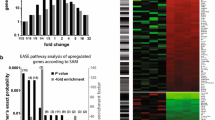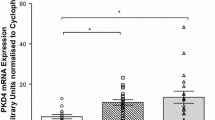Abstract.
Studies of starvation and refeeding have implicated the genes coding for uncoupling protein-3 and -2 (UCP3, UCP2) as candidate genes in the regulation of lipids as metabolic fuels in skeletal muscle. To gain insight into the role of free fatty acid (FFA) flux in regulating the expression of these muscle UCP homologues, we recently reported that, in response to the anti-lipolytic agent nicotinic acid, utilized to reduce FFA flux at the input supply (i.e. circulating) level in fed and fasted rats, expression of the UCP3 and UCP2 genes was reduced in the soleus (predominantly slow-oxidative fibres), but not in the gastrocnemius (predominantly fast-glycolytic fibres) or tibialis anterior (predominantly fast-oxidative-glycolytic fibres) muscles. In the present study, we examined UCP2 and UCP3 gene expression in these muscles from fed or fasted rats treated with etomoxir, an inhibitor of FFA flux at the output (i.e. mitochondrial oxidation) level. Fasting per se resulted in a threefold increase in serum FFA (P<0.001) and in marked increases in the messenger ribonucleic acid (mRNA) expression of both UCP2 and UCP3 in all three muscles (P<0.001). Treatment with etomoxir had no significant effect on serum FFA in the fed rats, but further elevated serum FFA in the fasted rats (P<0.001). The mRNA levels of both UCP3 and UCP2 in response to etomoxir were significantly reduced in the tibialis anterior muscle in both fed and fasted states (P<0.01), unaltered in the gastrocnemius muscle in both fed and fasted states and unaltered in the soleus muscle in the fed state, but increased in the fasted state, in parallel with the etomoxir-induced changes in serum FFA levels. Taken together, these results suggest the existence of positive feedback loops between FFA flux and muscle UCPs only in oxidative muscles – with that loop operating at the input FFA supply level for muscles with predominantly slow-oxidative fibres, and at the output FFA oxidation level for muscles with predominantly fast-oxidative-glycolytic fibres.
Similar content being viewed by others
Author information
Authors and Affiliations
Additional information
Received after revision and accepted: 19 May 1999
Electronic Publication
Rights and permissions
About this article
Cite this article
Samec, S., Seydoux, J. & Dulloo, A. Skeletal muscle UCP3 and UCP2 gene expression in response to inhibition of free fatty acid flux through mitochondrial β-oxidation. Pflügers Arch – Eur J Physiol 438, 452–457 (1999). https://doi.org/10.1007/s004249900080
Received:
Issue Date:
DOI: https://doi.org/10.1007/s004249900080




